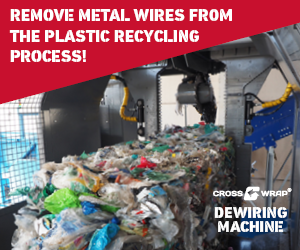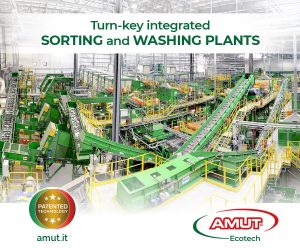
From left: Keefe Harrison, Jennifer Russell and Matt Seaholm. | Big Wave Productions/Plastics Recycling Update
How to make plastics sustainable and improve recycling infrastructure was the focus of a recent panel discussion, with stakeholders pointing to transparency, public trust and standardization.
The March 7 session, “Recycling’s Role in a Sustainable Future,” was part of the 2023 Plastics Recycling Conference held in National Harbor, Md.
Panelists were Steve Alexander, president and CEO of the Association of Plastic Recyclers; Erica Nuñez, program officer of the plastics initiative at The Ocean Foundation; Matt Seaholm, CEO of the Plastics Industry Association; and Jennifer Russell, an assistant professor in the Department of Sustainable Biomaterials at Virginia Tech. It was moderated by Keefe Harrison, CEO of The Recycling Partnership. (The Association of Plastics Recyclers owns Resource Recycling, Inc., which publishes Plastics Recycling Update.)
Nuñez told attendees that “solving this is much bigger than just material recovery and an economic issue.”
“We are talking about real health and environmental impacts to our world, to our oceans, to our water, to our food sources, to our air that we breathe,” she said. “Your work is very valuable and necessary and needed to engage in this space, and it is much bigger than just recycling. It is actually more about our world and what we leave behind.”
Approaching sustainability
The panelists agreed that while plastics cannot be considered sustainable without recycling, recycling alone is not the golden solution for plastic pollution.
Russell said sustainability “inherently requires consideration of human society existing within the biosphere and planetary boundaries, and if we fail to deal with that end-of-life challenge, there is no sustainability.”
“My fear is that sometimes the conversation becomes too myopic and too focused and we have to keep stepping back and remembering that bigger picture of ‘why have we made this in the first place?'” she said. “And how can we do so in a way that doesn’t cause extensive damage for the next 100 or 150 years?”
Seaholm said there are “a lot of opportunities there to do better and better and better. “
“At the end of the day we do need to recycle more because I don’t think we can really say plastic is a sustainable industry without recycling,” he added.
Considering the whole life cycle
Nuñez said recycling is a big piece of the solution, but so is reduction and simplification.
“How we make plastics in the beginning stages, the amount of chemicals and additives and processing aids that are used are also components that make a lot of these materials not useful to be recycled or are not healthy to be recycled,” she said.
“Let’s look at the production side of things,” Nuñez continued, “and make the materials from the beginning so that they can be recycled, and then have mechanisms that allow for the collection like EPR, like deposit return schemes.”
She added that the question of sustainability is “a whole puzzle.”
“You can’t take an issue or a product or a material like plastics that is literally everywhere and can do anything and think that one thing is going to fix the consequences of it,” she said.
Alexander added that solving plastic recycling issues “is like trying to put a man on the moon.”
He suggested looking first at packaging development and design to make sure everything is compatible with recycling.
“It’s going to require every company to do this, because at the end of the day, the solution has been left to the recycling infrastructure to solve the problem of volume and design of packaging, and we can’t do it that way,” he said.
Messaging consistency
Another important aspect of success is regaining public trust. Alexander said standardization and harmonization of recycling programs is critical. Russell added that for the last 30 years “we’ve done a huge disservice to the general public by calling them consumers.”
“They don’t consume plastic, they consume products,” she said, adding that although the industry sees the public as having all the power over what they purchase and whether they put it in the correct bin, that’s not how the public sees themselves.
“They go into the grocery store and they see seven different resin codes, not knowing which are appropriate for where they live or what that even means,” she said. “We’ve made it impossible for them to participate. We’ve confused the issue. We’ve changed the message hundreds of times.”
On top of that, Russell said the industry has spent money and time fighting policy to improve the system.
“There’s a lot of mixed messages and that not only erodes trust, but it’s made them unwilling to participate, and that they are the key player in this system,” she said. “If you can’t get them to put it into the right container, the rest is a moot point.”
Below is video of the full “Recycling’s Role in a Sustainable Future” session (story continues below video). Visit our Vimeo page to see more from the 2023 Plastics Recycling Conference.
How to fix it
Russell also suggested solutions, starting with being more transparent and embracing complexity, such as asking people to sort items, and trusting they will be able to handle it.
“Complexity is not something to be afraid of. Complexity is something that we already are,” she said. “We know how to communicate. You can communicate about climate change without having to describe the mechanics of atmospheric science. We can do the same thing with recycling and bring people into the conversation so that they can participate.”
Convenient recycling infrastructure is another key part of the solution, Seaholm added, which means including upgrades to decades-old MRF equipment and adding more ways to get items into the stream.
“We have to make it easy for consumers to recycle,” he said. “I always say people don’t feel guilty about using plastic – they feel guilty when they’re done using plastic. It’s because it’s not easy, if there’s not a receptacle right there, if they’re in a public place, to get it into the stream.”
Investment is needed, Alexander agreed, but “the last thing that we need is government investment.”
He said he preferred to see long-term contracts to provide stable markets and stable material supply over grants from Congress, because if the market is stable the industry will make the investment itself.
“We need some foundational restructuring in terms of the business-to-business component of the recycling industry,” he said.
Nuñez said better regulation and transparency around chemical additives will also help solve some of the circularity problems in the system today. EPR can help with that, she added, but it would be best at a higher, federal level than the current patchwork.
“The message for this conversation is we need some more national-level regulations,” she said. “I know that’s a bad word. I know you guys hate regulations. I know it’s a bad word, but it can also create the environment that you need to meet recycled content standards, to meet all these other requirements that are coming to you hard and fast.”
In parting, Russell told attendees that actions speak louder than words, “because we have to rebuild trust with the consumer and that’s not going to happen through a bunch of platitudes and wish lists and sustainability reports.”
“That’s going to happen by supporting local legislation or local programming, helping to get access, supporting the Recycling Partnership and being a face for this industry in a visible way, not an audible way,” she said.
More stories about industry groups
- California lawmakers look to quantify PCR imports
- Q&A: With EPR incoming, end markets are crucial
- NY legislative session ends, again without EPR



